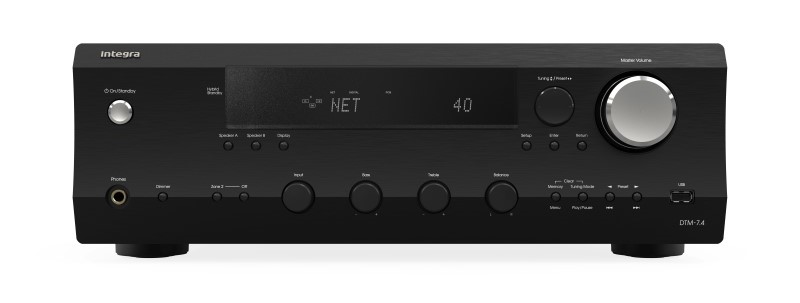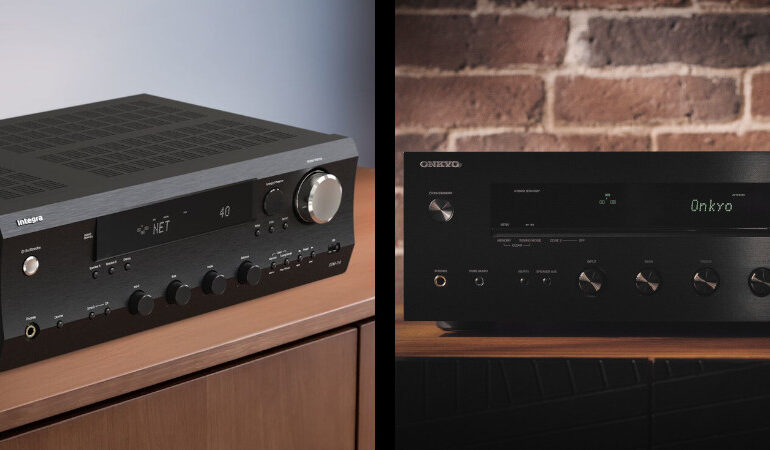Onkyo TX-8470 and Integra DTM-7.4 – Which is the Best Stereo Receiver for You?
There aren’t a lot of stereo AV receivers on the market these days. When two hit the market at the exact same time, one wonders which is the best. Onkyo and Integra are sister companies and often release similar products built on the same platform. But that doesn’t mean they are exactly the same product. What are the differences between the Onkyo TX-8470 and the Integra DTM-7.4? Let’s take a closer look!
What are the Onkyo TX-8470 and the Integra DTM-7.4?
The Onkyo TX-8470 and the Integra DTM-7.4 are both billed as stereo networked receivers. They sport a combination of HDMI and analogue (RCA) inputs and an HDMI ARC output. You might be wondering why the output isn’t eARC but with only two-channel support, that’s unnecessary. The Onkyo and Integra straddle two worlds. They have dedicated phono inputs (MM and MC compatible) as well as the ability to stream many online services. The clear customers for these products are those that want a device that is optimized for music in all its various delivery methods as well as doubling as a device to upgrade their TV’s audio.


Aesthetics
As we glance at the front panels of the two stereo receivers, we see some aesthetic as well as functional differences. the Integra has a more interesting faceplate with a concave and angled front while the Onkyo sports the typical flat face. There seem to be buttons and dials in all the same locations but a closer look will reveal differences. While nearly all the buttons seem to control the same functions, they are located in different spots on the front face. This indicates that, at the very least, the internal wiring is different.


Back Panel
Other than the color of the back panel, the differences between the Onkyo TX-8470 and the Integra DTM-7.4 become more clear. While the inputs and outputs are all identically placed, there are extra connections on the Integra. This is to be expected as Integra is typically targeted towards custom integrators. We find an RS-232 port for custom control as well as IR in/out ports and two 12-volt triggers. The 12-volt triggers, in particular, might be of interest to many people. If you plan on adding an external amp to your stereo receiver, having 12-volt trigger control means you can have your external amp power on with your receiver instead of relying on other solutions like the notoriously finicky “auto-on” sensing.
Specs
Internally, the major specs of the Onkyo TX-8470 and the Integra DTM-7.4 are the same. They have 110 watts of Class-G power. Class G is nearly identical to the standard Class A/B amps found in most AV receivers. The difference is that they have two power supplies: one for low power and one for high power output. This allows them to be more efficient and create less heat than your traditional Class A/B amps. As The Onkyo TX-8470 and the Integra DTM-7.4 are both billed as suitable for smaller spaces, this heat savings will be important for easier placement.

Features and connections are nearly identical with both sporting the AKM Premium 768 kHz / 32-bit Hi-Grade 2-Channel DAC, four in and one out HDMI connections supporting 8K up to 40Gbps, HDMI ARC technology, three digital audio inputs (two Optical and one Coaxial), and three RCA analogue audio inputs. It has pre-outs for the main speakers as well as Zone 2 and a single subwoofer output. On the streaming side, the Onyko supports Spotify, Amazon Music HD, Tidal, Deezer, TuneIn radio, and works with Sonos. The Integra lists Spotify, Amazon Music HD, Tidal, Deezer, Pandora, and TuneIn radio. Both say they are Roon Ready, have Chromecast built-in for audio, and support AirPlay.
The big difference in the specs is on the installer side. The Integra DTM-7.4 has a slew of control features that will make it super easy for custom installers to integrate it into a system.
- Web setup, download configuration files via browser
- Front ping button (“Display” key) to see the IP address
- IP control, RS232, IR in/out, and 12v triggers
- Control and remote diagnostic (C4, Crestron, OvrC, Domotz)
- Compatible with OVRC Pro, Domotz, Luxul Pro Watch, VPN, and other monitoring platforms
- Onboard diagnostics tool kit, including test patterns and EDID/HDCP adjustment, virtual remote; all available via web app
- Integra’s most robust API ever, with discrete commands for virtually any AVR function
- Custom control drivers based on Integrator feedback. Developed and maintained by Integra’s software team in Osaka, Japan
While these features might not mean a lot to you, what they mean to your installer is that they can integrate the Integra into your system with very precise control. The EDID/HDCP control, in particular, means they can diagnose and solve many HDMI issues that they couldn’t with other devices (including the Onkyo version of this stereo receiver). The discrete commands will also make custom installers happy as it allows them more precise control of the Integra DTM-7.4.
Which Is For You?
The price difference between the Onkyo TX-8470 and the Integra DTM-7.4 is minor. The Onkyo retails for $799 while the Integra lists for $900. If you don’t care about 12-volt triggers or IR controls, then the Onkyo has all the same internals as the Integra. If you are a custom installer, the Integra is the clear choice.


